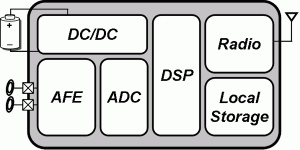A Low-Voltage ECG Analog Front-End for Wearable Systems
Advances in mobile electronics are fueling new possibilities for small, non-invasive, ambulatory medical monitoring systems that can be used to monitor a person’s vital signs. These wearable devices are shifting the focus of healthcare from the hospital to the patient and their everyday life. In a typical system, shown in Figure 1, the sensor interface, analog-to-digital converter (ADC), digital signal processor (DSP), radio and/or memory must all be powered from a small battery and fit in a small form factor. Given these constraints, the system complexity and energy consumption must be minimal.

Figure 2: A low-voltage, digitally-assisted AFE with on-chip ADC and DSP for wearable medical monitoring systems.
This work focuses on a fully-integrated, low-voltage analog front-end (AFE) to be used for ambulatory monitoring of a patient’s electrocardiogram (ECG). The design of such an interface is constrained by several considerations. First, ECG signals are on the order of 0.1–5mV in amplitude, residing in the 0.5–100Hz frequency range, thereby requiring a low-noise AFE that can reject low-frequency flicker noise. Second, to reduce the number of required voltage regulators and hence the system complexity, the AFE should be able to operate from the same supply as the DSP, which can be less than 1V [1]. Third, continuous ambulatory monitoring necessitates the use of dry electrodes to avoid using wet electrode gels, which may irritate the patient’s skin if worn long-term. However, the high electrode impedance of dry electrodes requires amplifiers to have a very high input impedance to avoid signal attenuation. Moreover, the AFE must also be able to reject up to ±300mV of electrode offset [2]. Lastly, the AFE must be able to deal with 50/60-Hz power-line interference (PLI), either through high common-mode rejection or notch filtering.
We propose a digitally-assisted AFE with an on-chip ADC and DSP that can operate off sub-1V supply voltages as shown in Figure 2. The core of the AFE is a chopper-stabilized instrumentation amplifier (I-AMP) to mitigate flicker noise, similar to that found in [3]. Electrode offset beyond the supply rails and high input-impedance are addressed by fully AC-coupling the inputs. Saturation in the front-end from PLI is avoided by using a mixed-signal feedback approach, in which PLI is filtered out digitally and fed-back in counter-phase at the input [4]. This approach cancels interference right at the input, enabling power savings through voltage scaling. Lastly, good noise-efficiency is achieved by carefully partitioning bias currents, resulting in a micro-power ECG AFE.
References
- J. Kwong, Y.K. Ramadass, N. Verma, and A.P. Chandrakasan, “A 65 nm Sub-Vt Microcontroller With Integrated SRAM and Switched Capacitor DC-DC Converter,” IEEE J. Solid-State Circuits, vol. 44, no. 1, pp. 115-126, Jan. 2009. [↩]
- IEC International Standard, Medical electrical equipment – Part 2-47: Particular requirements for the safety, including essential performance, of ambulatory electrocardiographic systems, International Electrotechnical Commission, 2010. [↩]
- N. Verma et al., “A Micro-Power EEG Acquisition SoC With Integrated Feature Extraction Processor for a Chronic Seizure Detection System,” IEEE J. Solid-State Circuits, vol. 45, no. 4, pp. 804–816, Apr. 2010. [↩]
- J.L. Bohorquez, M. Yip, A.P. Chandrakasan, and J.L. Dawson, “A Digitally-Assisted Sensor Interface for Biomedical Applications,” in Proc. IEEE Symposium on VLSI Circuits, Honolulu, HI, Jun. 2010. [↩]
